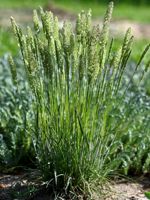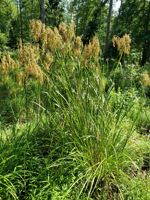Mon-Fri 9am - 5pm Mountain time
Junegrass vs Woolgrass
Koeleria macrantha
Scirpus cyperinus
NOT AVAILABLE THIS SEASON - MIGHT RETURN
CUSTOM GROW
Junegrass is a native, low-growing perennial bunchgrass commonly found in prairies and open woodlands. It is a great choice for prairie restoration and naturalization projects or an attractive accent in ornamental plantings. Spear-shaped seed heads rise above the gray-green lower leaves, maturing to a tan color. Flowering earlier than other upright prairie grasses, it greens up quickly in spring and maintains its appeal well into the fall. It is shorter in stature and rarely forms thick stands, which adds to its understated visual appeal.
Adapted to cooler climates, Junegrass thrives in well-drained, rocky, sandy, or gritty soils and can tolerate drought, cold, and high altitudes. It actively grows in spring and fall when soil temperatures are cool, but in areas that are too hot or humid, it may go dormant by late summer.
As a perennial, it dies back to the crown each winter, it will regrow from the base in the spring. Avoid disturbing the crown during late winter to ensure healthy growth the following season.
Woolgrass is a native perennial sedge that forms dense clumps in wetlands, ditches, and along shorelines. Its ability to thrive in saturated soils and shallow water, combined with its spreading growth habit, makes it especially valuable for waterside & riparian plantings, erosion control, ecological restoration, and naturalization projects.
The distinctive spikelets are covered in brown woolly bristles, which is where it gets the name Woolgrass. It produces seeds that are eaten by waterfowl and small mammals, while its dense stems offer cover and nesting habitat. It grows most actively in spring and fall, slowing or going dormant in the summer heat.

